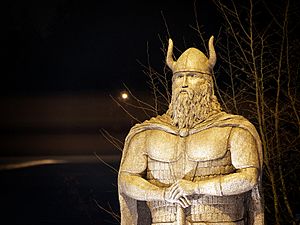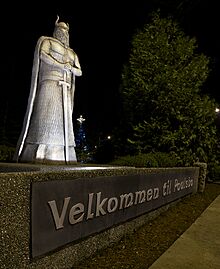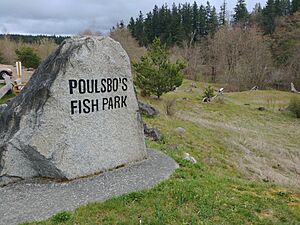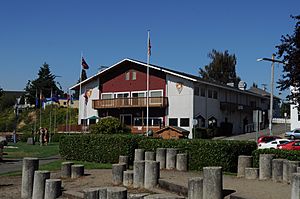Poulsbo, Washington facts for kids
Quick facts for kids
Poulsbo, Washington
č̓uʔč̓uɬac
|
|
|---|---|
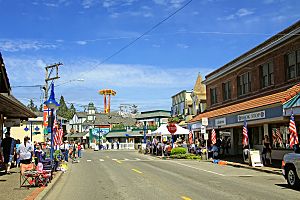
Front Street Northeast
|
|
| Nickname(s):
Viking City, Little Norway
|
|
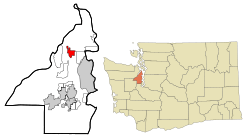
Location of Poulsbo, Washington
|
|
| Country | United States |
| State | Washington |
| County | Kitsap |
| Government | |
| • Type | Mayor–council |
| Area | |
| • Total | 5.37 sq mi (13.91 km2) |
| • Land | 4.74 sq mi (12.27 km2) |
| • Water | 0.63 sq mi (1.64 km2) |
| Elevation | 30 ft (9 m) |
| Population
(2020)
|
|
| • Total | 11,275 |
| • Estimate
(2022)
|
11,891 |
| • Density | 2,528/sq mi (910.20/km2) |
| Time zone | UTC-8 (Pacific (PST)) |
| • Summer (DST) | UTC-7 (PDT) |
| ZIP code |
98370
|
| Area code(s) | 360 |
| FIPS code | 53-55995 |
| GNIS feature ID | 1507605 |
Poulsbo (/ˈpɔːlzboʊ/ PAWLZ-boh) is a city on Liberty Bay in Kitsap County, Washington, United States. It is the smallest of the four cities in Kitsap County. The population was 11,970 at the 2020 census and an estimated 10,927 in 2018.
The Suquamish people have inhabited the surrounding area, called č̓uʔč̓uɬac in Lushootseed, for millennia. After the signing of the Treaty of Point Elliott in 1855, many were moved to the Port Madison Indian Reservation. Poulsbo was then founded in the 1880s by Norwegian immigrant Jørgen Eliason, who was joined by other Scandinavians who relocated from the Midwestern states. They were drawn here by the availability of land, by the area's rich resources, and by a landscape similar to their native home. The settlement was connected by boats to other areas of the region, including the Puget Sound mosquito fleet, which was eventually usurped by highways built in the early 20th century.
Modern-day downtown Poulsbo maintains a Scandinavian theme to honor its early immigrant history and is a popular regional tourist destination. One of its local products, Poulsbo Bread, is made locally at Sluys Bakery and used to be sold internationally. Many visitors arrive by boat; there are three marinas near the town, and the town's harbor is an excellent anchorage.
Contents
History
The Suquamish people have inhabited Liberty Bay for millennia, hunting in local forests and floodplains, fishing in bays and streams, and harvesting shellfish along the shoreline. The site upon which the modern city is built is called č̓uʔč̓uɬac, meaning "maple trees". The Suquamish had a winter village nearby, at the head of Liberty Bay, anglicized variously as "Ho-Cheeb" and "Xoyacid," which consisted of two large houses and four smaller houses. It existed until the late 1800s until settlers began populating the area.
After the signing of the Treaty of Point Elliott in 1855, most of the Suquamish people living in the area were relocated to the Port Madison Indian Reservation.
Founded by Norwegian immigrant Jørgen Eliason in the 1880s, Poulsbo was settled in its early years by a large number of Norwegian and other Scandinavian immigrants because of its similarities to their native countries. In 1886, Iver Brynildsen Moe, one of the early Norwegian settlers, suggested that the community should have a post office. Moe suggested the town be named "Paulsbo", his hometown in Halden, Norway. The community's petition for a post office was granted and Moe became the first postmaster, but authorities in Washington, D.C. misspelled the town's name, likely misreading Moe's handwriting, and the community became known as "Poulsbo" thereafter. Poulsbo was incorporated on December 18, 1907.
On September 15, 1914, after a dry summer with multiple previous brush fires, a large portion of the downtown business district was destroyed in a fire. Eight business buildings, an estimated third of the business section, were destroyed, with another damaged. The cause of the fire was never determined. Businessowners who lost their buildings continued business in undamaged buildings while downtown was rebuilt. After the fire, new buildings were constructed with cement rather than wood.
Until World War II, many Poulsbo residents retained Norwegian as a primary language. However, during World War II, the military constructed about 300 residential units to provide housing for workers at the nearby Puget Sound Naval Shipyard in Bremerton. The population of Poulsbo almost tripled over three years, and the diversification of the population led to the dominance of English as the primary language.
On October 22, 1975, King Olav V of Norway visited Poulsbo as part of the celebration of 150 years of Norwegian immigration to the United States. His son, Harald, visited 20 years later.
Education
Poulsbo is home to many different public schools in the North Kitsap School District. North Kitsap High School, Poulsbo Middle School, Poulsbo Elementary School and Vinland Elementary School are located within the city limits, while Pearson Elementary School lies south of town. Private schools include Gateway Christian School and West Sound Academy. Post-secondary undergraduate education includes Olympic College Poulsbo.
Chief Kitsap Academy in Suquamish is outside of the Poulsbo city limits and has a Poulsbo postal address.
Northwest College of Art & Design was formerly in the Poulsbo area. The school, established in 1982 as the Northwest College of Art, was initially in Lemolo in Poulsbo. In 1991 the institution began leasing the former Mains Manor in Suquamish, which was purchased in 2000. The Suquamish tribe had purchased the former college building for $5.03 million on November 28, 2017, and made it into the current Chief Kitsap Building. The college, at that time, moved to Tacoma, having purchased a building there.
Geography
Topography
Poulsbo is located in northern Kitsap County at 47°44′21″N 122°38′21″W / 47.739137°N 122.639278°W (47.739137, -122.639278), at the north end of Liberty Bay, a sheltered arm of Puget Sound. Washington State Route 305 has its northwestern terminus in the northern part of the town at State Route 3 and leads southeast 13 miles (21 km) to the ferry docks at Bainbridge Island. SR 3 leads north 9 miles (14 km) to Port Gamble and south 16 miles (26 km) to the western part of Bremerton.
According to the United States Census Bureau, Poulsbo has a total area of 5.27 square miles (13.65 km2), of which 4.67 square miles (12.10 km2) are land and 0.60 square miles (1.55 km2), or 11.43%, are water.
Surrounding municipalities
 |
Hood Canal | Port Gamble | Kingston |  |
| Bangor | Suquamish, Indianola | |||
| Bangor, Silverdale | Scandia, Pearson, Virginia, Keyport | Bainbridge Island |
Climate
| Climate data for Poulsbo, Washington | |||||||||||||
|---|---|---|---|---|---|---|---|---|---|---|---|---|---|
| Month | Jan | Feb | Mar | Apr | May | Jun | Jul | Aug | Sep | Oct | Nov | Dec | Year |
| Record high °F (°C) | 62 (17) |
71 (22) |
80 (27) |
83 (28) |
92 (33) |
97 (36) |
99 (37) |
101 (38) |
97 (36) |
86 (30) |
70 (21) |
68 (20) |
101 (38) |
| Mean daily maximum °F (°C) | 47 (8) |
49 (9) |
54 (12) |
59 (15) |
65 (18) |
70 (21) |
76 (24) |
77 (25) |
71 (22) |
60 (16) |
51 (11) |
45 (7) |
60 (16) |
| Mean daily minimum °F (°C) | 36 (2) |
35 (2) |
38 (3) |
41 (5) |
46 (8) |
51 (11) |
54 (12) |
55 (13) |
50 (10) |
44 (7) |
39 (4) |
34 (1) |
44 (7) |
| Record low °F (°C) | 12 (−11) |
12 (−11) |
19 (−7) |
28 (−2) |
27 (−3) |
38 (3) |
41 (5) |
39 (4) |
33 (1) |
27 (−3) |
10 (−12) |
7 (−14) |
7 (−14) |
| Average precipitation inches (mm) | 8.89 (226) |
6.22 (158) |
5.95 (151) |
3.57 (91) |
2.46 (62) |
1.69 (43) |
0.86 (22) |
1.03 (26) |
1.55 (39) |
4.89 (124) |
9.39 (239) |
10.07 (256) |
56.57 (1,437) |
Culture
Media
The North Kitsap Herald has published continuously since 1901, providing local news for Poulsbo as well as the greater Kitsap County area. The Herald was founded by Peter Iverson, who served as mayor of Poulsbo and state legislator. Today, the Herald is owned by Sound Publishing. In Kitsap, Sound also publishes the Bainbridge Island Review, Central Kitsap Reporter, and Port Orchard Independent (Fridays); Kingston Community News (monthly); as well as KitsapDailyNews.com and BainbridgeReview.com (daily online).
Landmarks
First Lutheran Church opened in 1886 atop the hill, overlooking downtown Poulsbo, and was originally Førdefjord Lutheran.
Norseman Statue
The Norseman Statue (47°44′50″N 122°39′17″W / 47.74719°N 122.65469°W), a 12-foot (3.7 m) statue by artist Mark Gale of Tacoma, stands at Viking Avenue and Lindvig Way.
The statue was commissioned by the city to replace a wooden sign at Viking Avenue and Lindvig Way. The statue was created by Tacoma, Washington-based artist Mark Gale. The project was coordinated by local businessman Bill Austin and Poulsbo Mayor Becky Erickson. Privately funded by the Bjorgen Beautification Fund, the statue cost $25,000. It was unveiled on November 23, 2012, at a traditional city tree lighting ceremony.
The statue constitutes 500 pounds of rebar steel and 5,000 pounds of cement. It stands on a foundation engraved with the words Velkommen til Poulsbo. It is located on the western edge of town, on the southeast corner of Viking Avenue NW and NW Lindvig Way.
Parks
Poulsbo's Fish Park (47°44.862′N 122°39.190′W / 47.747700°N 122.653167°W) is a 40-acre (16 ha) park in Poulsbo. The park was started in 2002 by a group of community members and governments including the City of Poulsbo and the Suquamish Tribe.
The park is centered on the Dogfish Creek estuary at the north end of Liberty Bay. As of 2015[update], the park had 1.5 miles (2.4 km) of trails, with the city planning to double that figure.
During the fall salmon run, Washington State University's extension service conducts salmon tours at locations on Kitsap Peninsula including Fish Park.
Sister cities
Poulsbo has two sister cities, both in Norway:
Demographics
| Historical population | |||
|---|---|---|---|
| Census | Pop. | %± | |
| 1910 | 364 | — | |
| 1920 | 546 | 50.0% | |
| 1930 | 584 | 7.0% | |
| 1940 | 639 | 9.4% | |
| 1950 | 1,014 | 58.7% | |
| 1960 | 1,505 | 48.4% | |
| 1970 | 1,856 | 23.3% | |
| 1980 | 3,453 | 86.0% | |
| 1990 | 4,848 | 40.4% | |
| 2000 | 6,813 | 40.5% | |
| 2010 | 9,200 | 35.0% | |
| 2020 | 11,970 | 30.1% | |
| U.S. Decennial Census | |||
2010 census
As of the 2010 census, there were 9,200 people, 3,883 households, and 2,310 families residing in the city. The population density was 1,970.0 inhabitants per square mile (760.6/km2). There were 4,115 housing units at an average density of 881.2 per square mile (340.2/km2). The racial makeup of the city was 82.9% White, 9.2% Hispanic or Latino, 5.7% Asian, 1.1% African American, 0.9% Native American, 0.3% Pacific Islander, 3.6% from other races, and 5.4% from two or more races.
There were 3,883 households, of which 30.8% had children under the age of 18 living with them, 61% were married couples living together, 11.4% had a female householder with no husband present, 3.2% had a male householder with no wife present, and 40.5% were non-families. 34.7% of all households were made up of individuals, and 17.4% had someone living alone who was 65 years of age or older. The average household size was 2.30 and the average family size was 2.97.
The median age in the city was 40.2 years. 23.8% of residents were under the age of 18; 7.8% were between the ages of 18 and 24; 24.7% were from 25 to 44; 24.5% were from 45 to 64; and 19.4% were 65 years of age or older. The gender makeup of the city was 45.3% male and 54.7% female.
Notable residents
- Tarn Adams — creator of Dwarf Fortress
- Margaret Olofsson Bergman — weaver
- Jack Colletto — American football player
- James W. Douglass — author, peace activist, and Gandhian nonviolent Christian theologian
- Jason Everman — former member of Nirvana; U.S. Army Special Forces
- Richard F. Gordon Jr. — Apollo 12 astronaut
- Aaron Sele — Major League Baseball pitcher
- Scott Shipley — Olympic canoeing medalist
- Harland Svare —former NFL player and coach
- Ryan Villopoto — pro motocross rider
Major roads
 SR 3
SR 3 SR 305
SR 305 SR 307
SR 307
See also
 In Spanish: Poulsbo (Washington) para niños
In Spanish: Poulsbo (Washington) para niños




